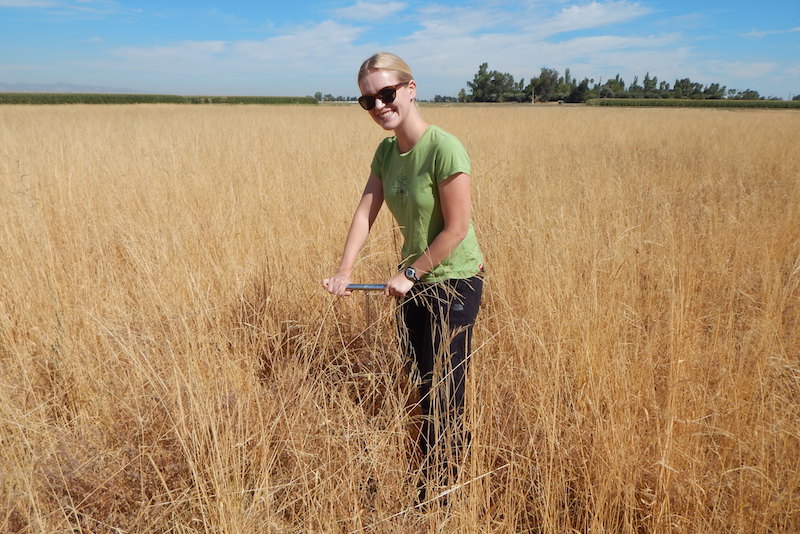Invasion of the Poultry Manure Microbes. Or Maybe Not.

Kelly Gravuer takes a soil sample at Russell Ranch. Her soil microbe study for her Ph.D. at UC Davis yielded unexpected results.
By Lisa Howard
February 27, 2017
Adding compost to soil introduces needed carbon and nutrients, but less is known about what happens to the existing microbiome.
Can microbes within the compost successfully “invade” the resident community? And if so, how long do they stick around? How do the resources and microbes in the compost affect the resident microbe populations?
As a doctoral student at UC Davis, Kelly Gravuer, now a postdoc with Arizona State University and The Nature Conservancy, decided to explore these questions.
She collected soils from three different plots at the Russell Ranch Sustainable Agriculture Facility: One that grew organic tomatoes and corn; one that grew conventional tomatoes and corn (meaning synthetic fertilizers and pesticides were used); and one that grew no-input wheat (meaning no added compost, fertilizer or irrigation).
Gravuer then added composted poultry manure to the three soil types and used DNA sequencing to track the microbiome species at days four and 32. What she found wasn’t so much an invasion as a small infiltration.
“A small group of compost microbes did establish in each soil, comprising five to 10 percent of the total soil community four days after the compost was added, and two to three percent 32 days after the compost was added,” said Gravuer. All three soils saw an increase in the overall microbe count in response to the carbon and nutrients added by the compost.
Microbial Count Increases but Not Necessarily Diversity
But the invasion of new species of microbes from the compost – and the overall effects of compost on the resident community – differed depending on the type of soil.
Organic soil was least “invadable” by the compost microbes. Conventional soil had a brief increase in microbial diversity. But the surprise was the no-input soil from the wheat field: It showed a decline in microbial diversity.
Experiments with plant invasion models has found that adding resources to resource-poor environments, like the soil from the wheat field, can increase the resident community diversity.
“We thought we might see similar patterns with our soil communities, but instead we found the opposite. The no-input soil became less diverse. Clearly, we still have a lot to learn about how to translate knowledge gained from plant and animal experiments to the vastly different world of microbes,” Gravuer said.
She notes that If preserving microbial diversity is an important management goal in a low-nutrient soil, adding compost may not be the best way to go. But if increasing the abundance is important – as it often is for goals such as suppressing disease and soil carbon sequestration – then the tradeoff might be worth it.
As a caveat, she notes the experiment was done in jars in the lab. “The next step would be to confirm that these patterns also occur in the field plots themselves,” said Gravuer.
Media Contacts
Kelly Gravuer, (UC Davis Ph.D. Ecology, ’16), Postdoctoral Research Associate, Arizona State University, 215-485-2547, [email protected]
AJ Cheline, UC Davis Office of Research, 530-752-1101, [email protected]

